
Overview
The article asserts the necessity of optimizing e-commerce subscription models to enhance profitability by thoroughly understanding client needs and leveraging data-driven strategies. It highlights that aligning subscription services with customer preferences and delivering personalized experiences can significantly elevate client satisfaction and retention. This approach not only leads to increased revenue but also fosters long-term loyalty among customers.
Introduction
Understanding the intricacies of e-commerce subscription models is increasingly vital for businesses aiming to enhance profitability and foster customer loyalty. By leveraging data-driven insights and aligning services with client needs, companies can craft tailored experiences that not only satisfy but also engage their subscribers. However, the rapid growth of the subscription economy brings significant challenges, notably customer churn and compliance issues. Brands must effectively navigate these complexities to optimize their subscription models for sustained success.
Parah Group: Optimize Your Subscription Model for Maximum Profitability
To enhance profitability within your service framework, it is imperative to thoroughly understand your clientele and their purchasing behaviors. By implementing data-driven strategies that analyze user interactions and preferences, you can significantly elevate your offerings.
Parah Group underscores the necessity of aligning subscription services with client requirements, ensuring that every aspect of the model contributes to revenue growth without incurring additional advertising costs. This strategy not only improves client satisfaction but also fosters long-term loyalty and sustainable profitability.
As highlighted by industry leaders, a satisfied client can generate 14 times more profit than an unsatisfied one, emphasizing the critical nature of investing in client experience. Furthermore, with memberships rising at an impressive rate of 60%, leveraging insights from client behavior analysis is essential for maintaining competitiveness in 2025 and beyond.
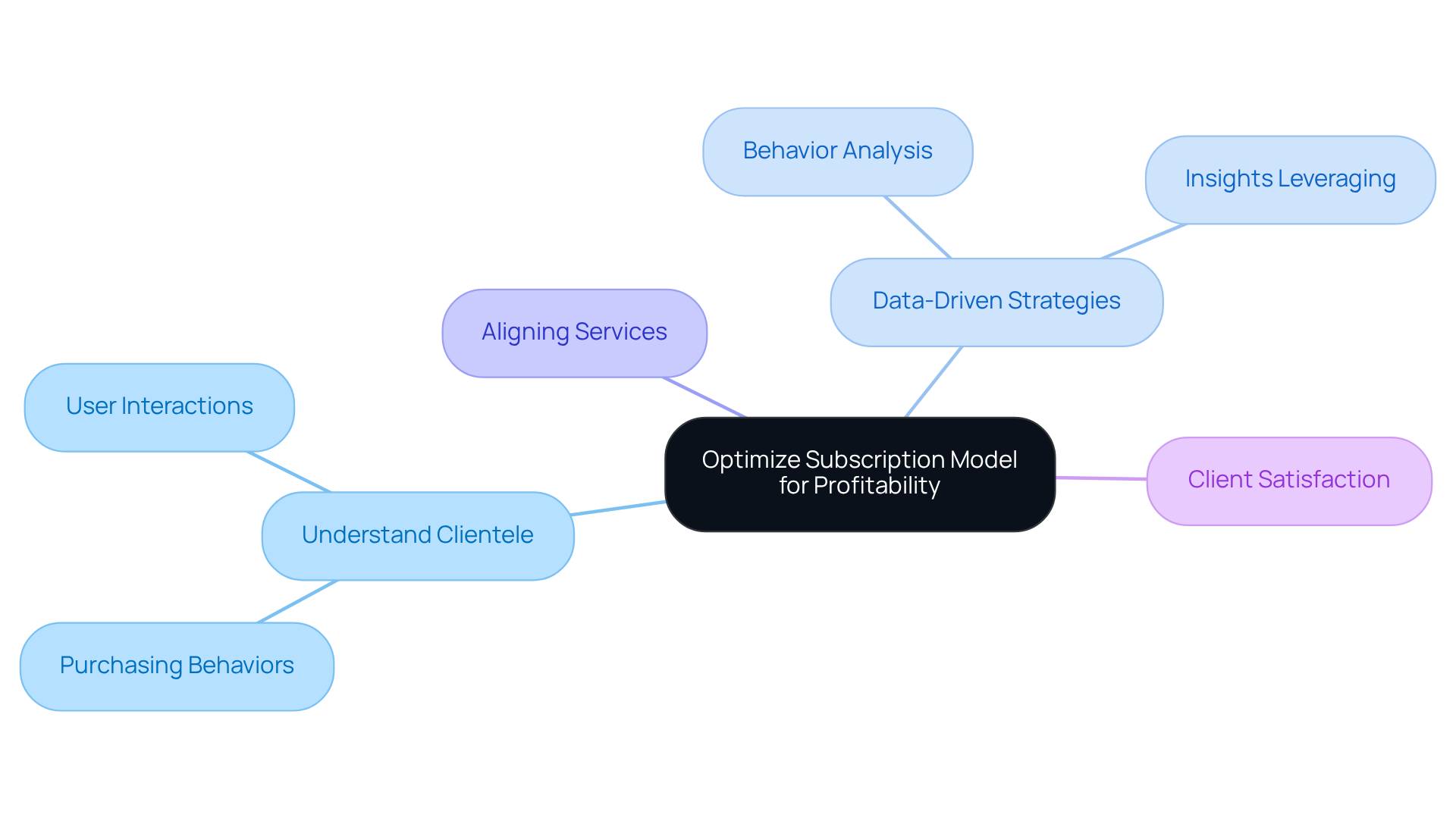
Types of Ecommerce Subscription Models: Replenishment, Curation, and More
E commerce subscription model systems can be classified into three primary categories:
- Replenishment systems focus on the repeated acquisition of essential products, ensuring that consumers never run out of what they need.
- Curation approaches, on the other hand, provide tailored selections based on individual buyer preferences, enhancing the shopping experience.
- Access frameworks grant subscribers exclusive content or products, creating a sense of privilege and belonging.
Each of these models, particularly the e commerce subscription model, offers distinct benefits and can be customized to meet the specific needs of your target audience, ultimately improving client retention and satisfaction.

Value Addition: How Ecommerce Subscription Models Enhance Customer Loyalty
E commerce subscription models significantly enhance customer loyalty by delivering consistent value and convenience. By offering personalized experiences and exclusive benefits, companies that adopt the e commerce subscription model cultivate a sense of belonging among subscribers. This emotional connection not only drives repeat purchases but also fosters long-term relationships in the e commerce subscription model, ultimately increasing lifetime value.
Marketing experts emphasize that creating emotional ties through tailored experiences is essential; it transforms mere transactions into meaningful interactions. Brands that prioritize exceptional service and unique offerings are more likely to sustain this loyalty, ensuring subscribers feel valued and engaged.
For example, companies that implement personalized rewards and member-only products experience heightened engagement rates, underscoring the necessity for loyalty programs to adapt to contemporary consumer expectations. By focusing on these strategies, businesses can effectively enhance client retention and promote sustainable growth in their service offerings.
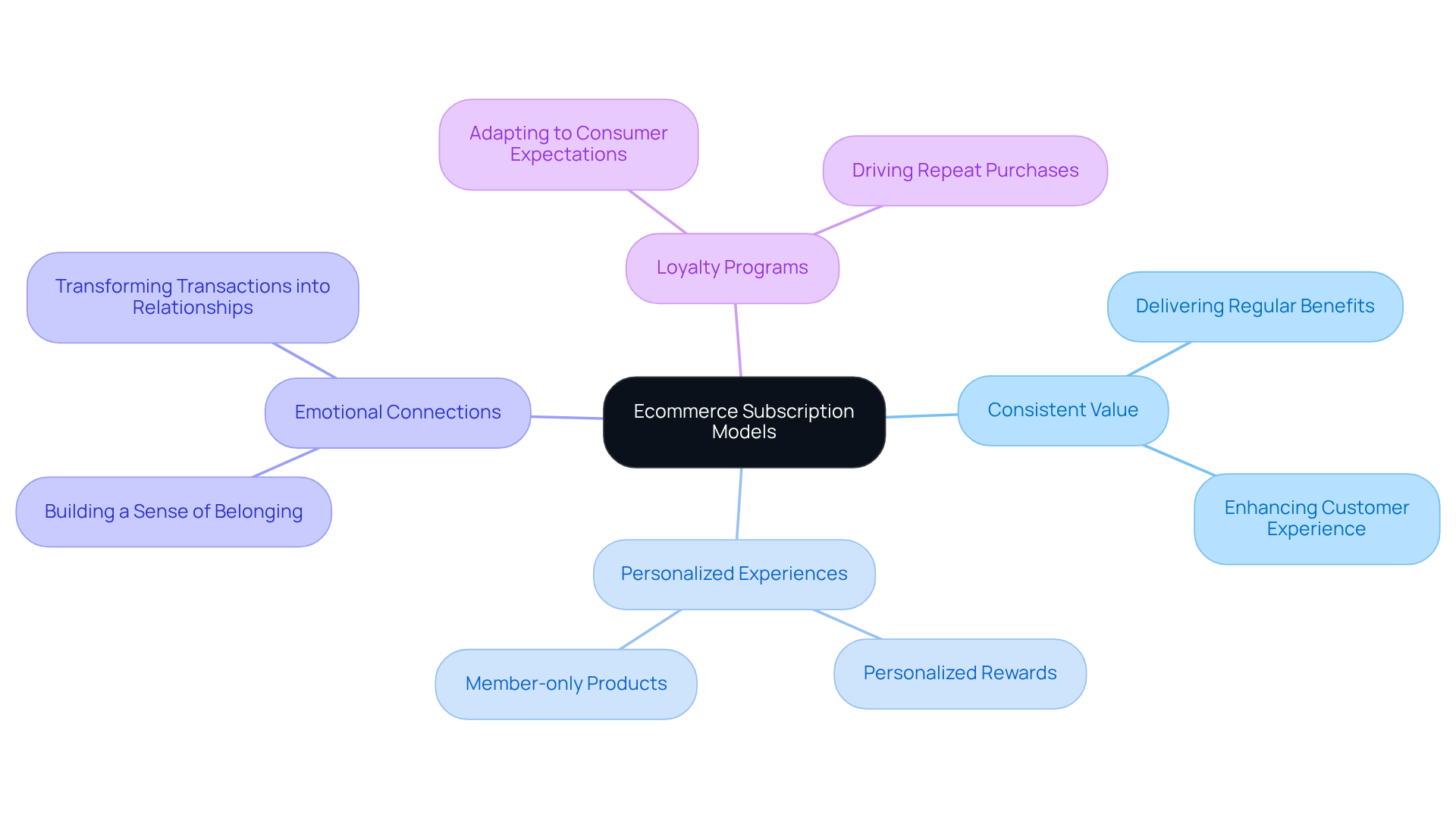
Challenges of Ecommerce Subscription Models: Navigating Customer Churn and Compliance
Client churn represents a significant challenge for ecommerce membership models, often driven by client dissatisfaction or a perceived lack of value. Statistics reveal that the average churn rate for e-commerce services hovers around 5%, serving as a critical benchmark for companies to evaluate their retention strategies. To mitigate churn, brands must prioritize consistent engagement with subscribers, actively solicit feedback, and adapt their offerings based on user insights. Research shows that 28% of clients identify personalized experiences as a primary reason for maintaining their subscriptions, highlighting the necessity for tailored interactions.
Moreover, compliance with regulations such as GDPR is vital for protecting client data and maintaining trust. Brands should invest in robust compliance frameworks, including:
- The implementation of data protection policies
- Regular audits
to effectively navigate these challenges. As Melinda Gates aptly states, "The voice of the client is the most powerful marketing tool you possess, so ensure you're listening." By cultivating a culture of feedback and responsiveness—establishing clear communication channels—brands can enhance customer satisfaction and foster long-term loyalty, ultimately reducing churn rates and driving sustainable growth.
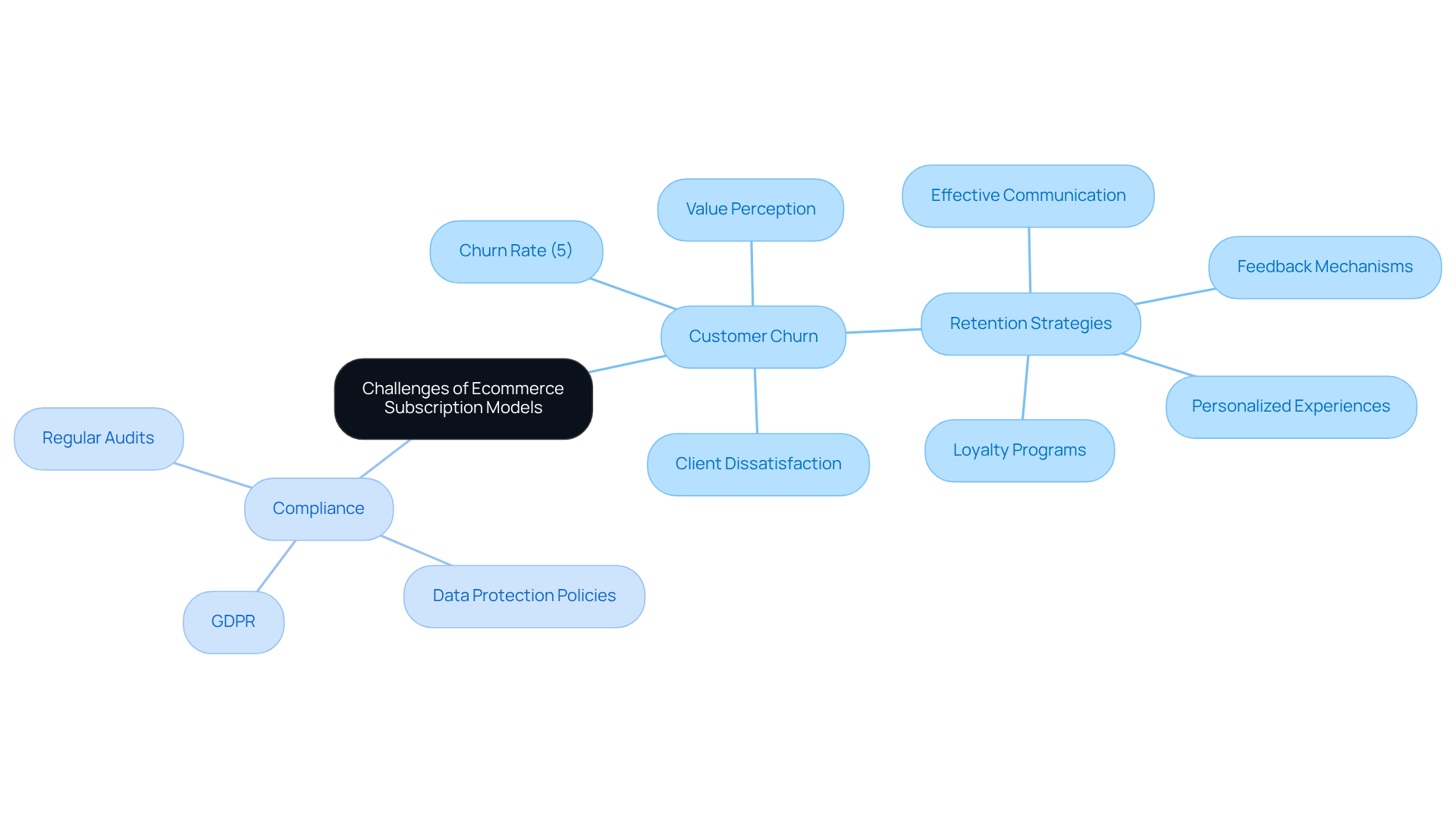
Key Success Factors for Ecommerce Subscription Models: Pricing, Tools, and Marketing Strategies
Successful e commerce subscription model systems rely on competitive pricing, robust management tools, and targeted marketing strategies. Brands must rigorously analyze market trends to set prices that not only reflect the perceived value of their offerings but also appeal to consumers.
The e commerce subscription model has allowed companies to exhibit a remarkable compound annual growth rate (CAGR) of 16.5%, significantly outpacing traditional models and growing 3.4 times faster than S&P 500 companies over the past 12 years. This trend underscores the critical importance of strategic pricing. Furthermore, a mere 1% improvement in pricing can yield an 11% increase in profits, emphasizing the pivotal role of effective pricing strategies.
Sophisticated management tools, such as automated billing systems and client relationship management (CRM) platforms, streamline operations and enhance the overall client experience. Additionally, targeted marketing campaigns that highlight the unique benefits of subscriptions—such as convenience and personalization—are essential for driving both acquisition and retention.
Notably, women account for 60% of memberships, while men are more likely to hold multiple active accounts, underscoring the necessity of understanding consumer behavior. By focusing on these vital elements, brands can adeptly navigate the competitive landscape of the e-commerce subscription model and foster enduring client loyalty.
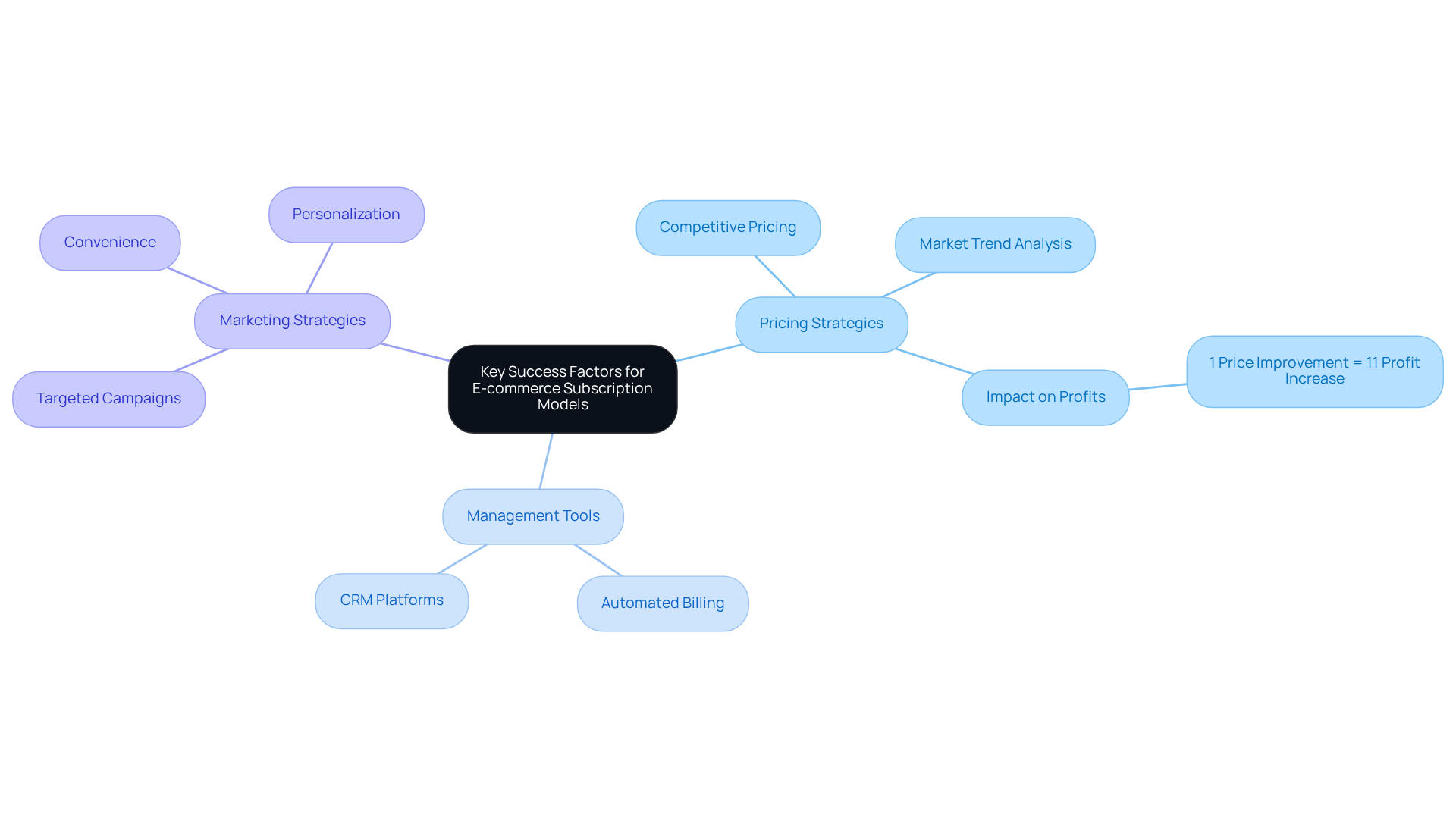
Common Mistakes to Avoid in Ecommerce Subscription Models: Logistics and Market Research
Common mistakes in the e commerce subscription model often arise from neglecting logistics and failing to conduct thorough market research. Brands frequently underestimate the importance of effective supply chain management, leading to delays and client dissatisfaction. Membership-based companies that prioritize logistics can significantly enhance client satisfaction and retention rates.
Moreover, a lack of understanding of the target market can result in misaligned offerings, ultimately impacting profitability. Comprehensive market analysis is essential for tailoring plans to meet client requirements and preferences, ensuring that offerings resonate with the intended audience.
As the membership economy continues to grow, projected to reach a valuation of $3 trillion in 2024, companies must leverage insights from market research to refine their strategies within the e commerce subscription model and avoid costly mistakes. Notably, organizations within the Subscription Economy Index have expanded 3.4 times faster than S&P 500 companies over the past 12 years, highlighting the growth potential in this sector.
Furthermore, 50% of service-based businesses identified app store and in-app purchases as the most effective acquisition channels, underscoring the necessity of understanding customer preferences. To effectively navigate the challenges of membership fatigue—where 39% of global users intend to cancel at least one service in the coming year—companies should consistently seek user feedback to adapt their offerings.

Customer Segmentation: Tailoring Your Subscription Model to Meet Diverse Needs
Customer segmentation is critical for tailoring model offerings to meet diverse consumer needs. By leveraging consumer information, companies can pinpoint specific segments based on preferences, purchasing behaviors, and demographics. This targeted approach facilitates the development of customized membership options within the e commerce subscription model that resonate with each group, significantly enhancing engagement and fostering loyalty. For instance, companies can design unique subscription levels that provide distinct advantages aligned with consumer preferences, such as early access to new collections or personalized product recommendations. Continuous refinement of segmentation strategies is essential, allowing companies to adapt to evolving consumer behaviors and preferences, ultimately improving the overall customer experience and nurturing long-term loyalty.
A segmented campaign can yield a staggering 760% increase in revenue, highlighting the financial advantages of effective segmentation. This is exemplified by Parah Group's partnership with a $30M apparel company, which saw a 35% boost in conversion rates after optimizing their website and leveraging social proof. Similarly, Grab Green, a $15M cleaning product brand, enhanced their average order value (AOV) by 80% through strategic segmentation and tailored offerings. These case studies illustrate how understanding client needs can drive effective membership frameworks in an e commerce subscription model and elevate profitability.
As Prasanna Kumar, Co-Founder of BLR Brewing Co., asserts, "Every client is worth 100 clients. Whether they spend ₹100 or ₹10,000, their feedback is invaluable." This underscores the importance of comprehending customer needs in cultivating effective e commerce subscription models. However, brands must also recognize potential challenges in segmentation, such as fragmented data and outdated insights, to ensure their strategies remain impactful.

Utilizing Advanced Tools and Platforms for Effective Subscription Management
Employing advanced tools and platforms for membership management is crucial for enhancing operational efficiency. Brands must prioritize software that includes features such as:
- Automated billing
- Client analytics
- Inventory management
These tools not only streamline processes but also provide invaluable insights into client behavior. Such insights empower brands to make data-driven decisions, ultimately enhancing the membership experience.
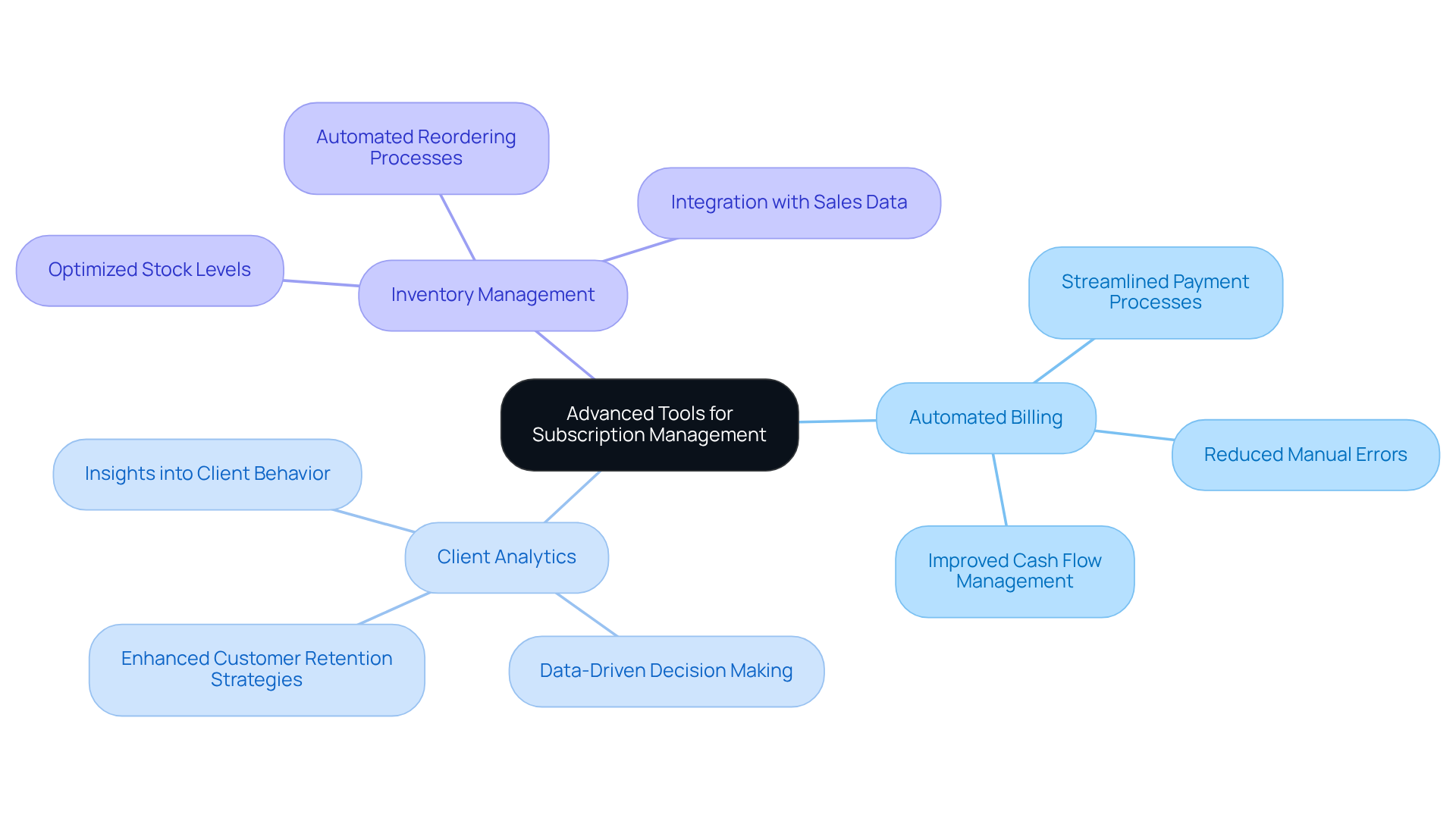
Ensuring Data Security and Compliance in Ecommerce Subscription Models
In the realm of the e commerce subscription model, ensuring data security and compliance stands as a fundamental pillar of client trust, transcending mere regulatory obligation. Brands must adopt stringent security measures to protect client information while adhering to regulations such as GDPR and CCPA. Regular audits and updates to security protocols are essential for mitigating the risks associated with increasingly prevalent data breaches. In fact, 84% of consumers express greater loyalty to companies that demonstrate strong security controls, underscoring the direct link between compliance and customer retention.
Transparency regarding data usage and protection measures is crucial. Brands that effectively convey their data management practices cultivate trust, which is essential for promoting renewals. As consumer awareness of data privacy grows—evidenced by 79% of consumers taking protective measures in 2023—companies must prioritize compliance to maintain a competitive edge. Notably, organizations that implement responsible data practices in the e commerce subscription model can see a 23% increase in purchase intent, highlighting the tangible benefits of prioritizing compliance.
With the evolving landscape of data privacy laws, companies must remain informed and proactive in their compliance efforts. The adoption of comprehensive privacy policies and regular training for employees can further enhance an organization's ability to navigate these complexities, ensuring that they not only meet regulatory requirements but also build lasting relationships with their customers. Additionally, the California Privacy Rights Act (CPRA) introduces specific rights for consumers, such as the right to correct inaccurate personal information and the right to limit the use and disclosure of sensitive personal information, which are crucial for understanding compliance requirements. Furthermore, the average privacy budget of $2.7 million reflects the financial commitment organizations are making towards compliance, emphasizing the importance of data security investments. Lastly, with 39% of consumers disabling location-based services in the past year due to privacy concerns, it is evident that compliance is not only a legal necessity but also a strategic requirement for businesses.
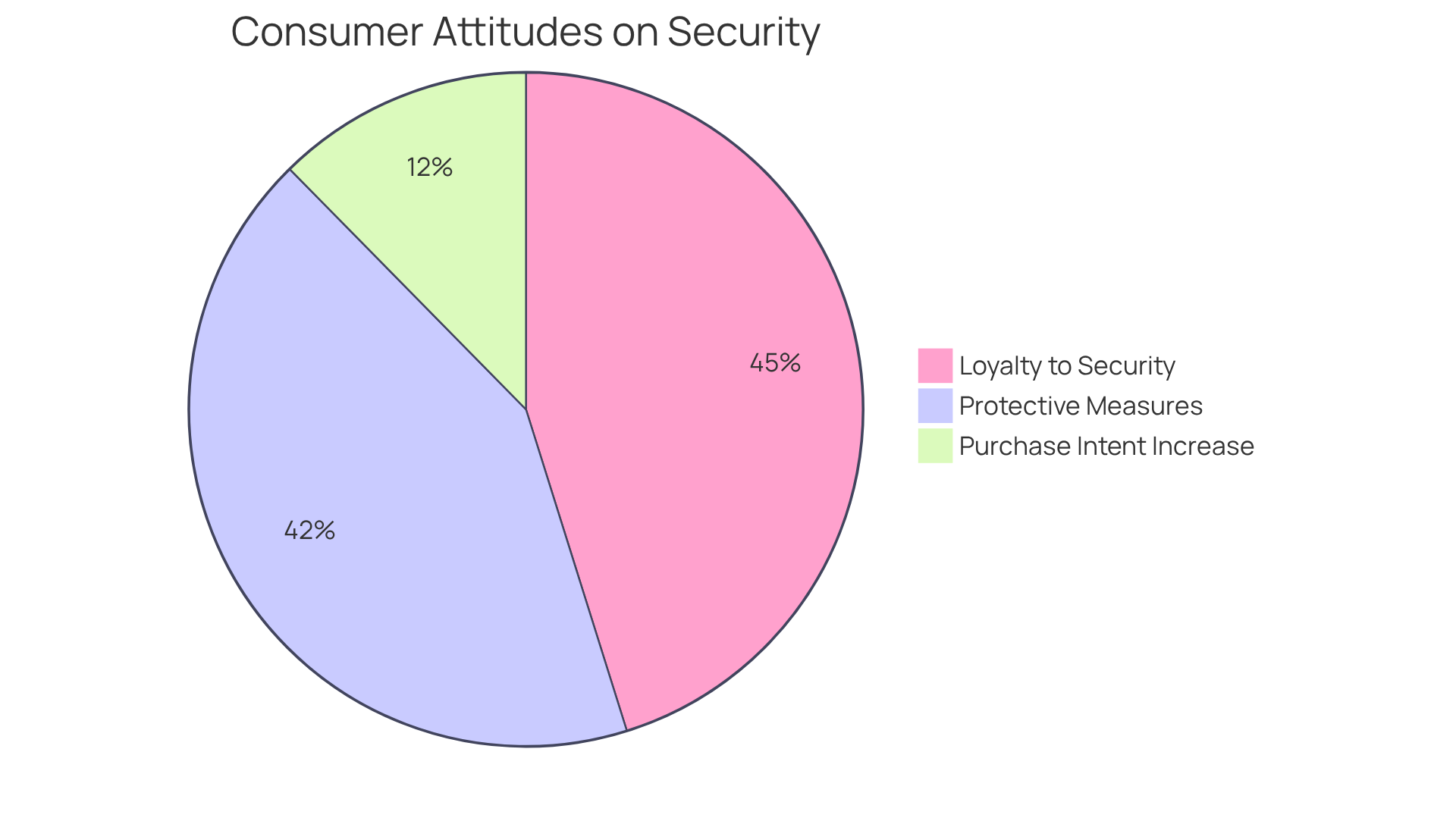
Future Trends in Ecommerce Subscription Models: Innovations and Market Dynamics
The future of the e commerce subscription model is set for significant evolution, driven by advancements in artificial intelligence and an increased focus on sustainability. Artificial intelligence is revolutionizing personalization, enabling brands to tailor experiences to individual preferences, which in turn enhances user engagement. For instance, predictive analytics can pinpoint at-risk subscribers, empowering businesses to deploy targeted retention strategies that markedly reduce churn rates. Brands that adeptly harness AI for personalization are likely to witness engagement rates soar, as emotionally connected subscribers demonstrate a 306% higher lifetime value compared to merely satisfied customers.
Moreover, the rise of hybrid models that integrate service plans with one-time purchases is gaining momentum. This strategy caters to diverse consumer preferences, offering flexibility while sustaining recurring revenue streams. As consumers increasingly prioritize sustainability, the provision of eco-friendly service options can set brands apart in a saturated marketplace. Companies that embrace these trends and innovate their offerings will not only enhance customer satisfaction but also fortify their position in the dynamic ecommerce landscape.
In conclusion, the integration of AI for hyper-personalization, the adoption of hybrid models, and a steadfast commitment to sustainability are pivotal trends that will shape the future of the e commerce subscription model, driving both engagement and profitability.
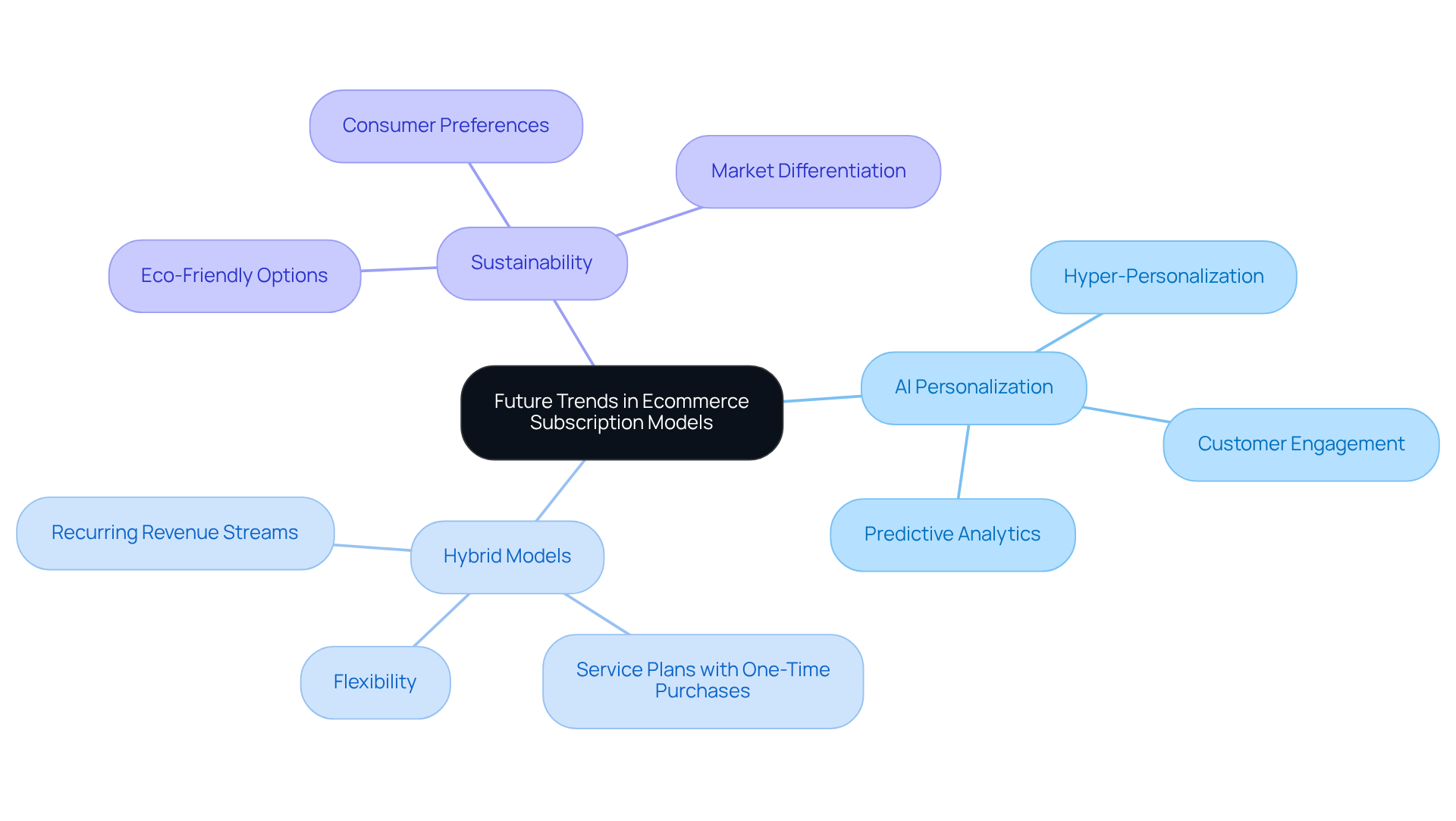
Conclusion
To achieve optimal profitability in e-commerce subscription models, understanding customer needs and behaviors is paramount. By employing data-driven strategies that align offerings with client expectations, businesses can enhance client satisfaction and foster long-term loyalty. The insights provided throughout the article emphasize the importance of tailoring subscription services to meet diverse consumer preferences, ensuring that every interaction contributes to a positive customer experience.
Key arguments presented include:
- The necessity of effective customer segmentation
- The significance of pricing strategies
- The critical role of advanced management tools
Additionally, the challenges of client churn and compliance highlight the need for brands to remain proactive in their engagement efforts and data protection practices. As the e-commerce subscription landscape evolves, staying ahead of trends such as artificial intelligence and sustainability will empower brands to drive engagement and profitability.
In light of these insights, companies are urged to prioritize customer-centric approaches in their subscription models. By continuously refining strategies based on consumer feedback and market dynamics, brands can mitigate churn and unlock new avenues for growth in the competitive e-commerce space. Embracing these best practices is essential for thriving in the subscription economy and securing a loyal customer base in the years to come.
Frequently Asked Questions
How can businesses enhance profitability within their subscription model?
Businesses can enhance profitability by thoroughly understanding their clientele and their purchasing behaviors, implementing data-driven strategies to analyze user interactions and preferences, and aligning subscription services with client requirements.
What is the importance of client satisfaction in subscription models?
Client satisfaction is critical as a satisfied client can generate 14 times more profit than an unsatisfied one. Investing in client experience is essential for fostering long-term loyalty and sustainable profitability.
What are the main types of e-commerce subscription models?
The main types of e-commerce subscription models are replenishment systems, which focus on repeated acquisition of essential products; curation approaches, which provide tailored selections based on individual buyer preferences; and access frameworks, which grant subscribers exclusive content or products.
How do e-commerce subscription models enhance customer loyalty?
E-commerce subscription models enhance customer loyalty by delivering consistent value and convenience, offering personalized experiences, and creating emotional connections that drive repeat purchases and long-term relationships.
What role do tailored experiences play in customer loyalty?
Tailored experiences transform transactions into meaningful interactions, creating emotional ties that increase customer loyalty. Brands that prioritize exceptional service and unique offerings are more likely to sustain loyalty among subscribers.
How can loyalty programs adapt to contemporary consumer expectations?
Loyalty programs can adapt by implementing personalized rewards and member-only products, which enhance engagement rates and ensure that subscribers feel valued and engaged.
FAQs











